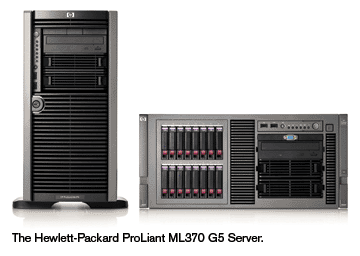Review: HP Server Handles The Heavy Load

The server can provide high performance and availability with continuous uptime to support corporate work groups and critical remote sites. It's also ideal for virtualization and has plenty of storage space for Web applications and databases. The server is available in multiple configurations, any of which are highly expandable to support business growth.

The HP ProLiant ML370 Generation 5 (G5) is available with dual- and quad-core Intel Xeon 5000 series processors, up to 64 Gbytes of memory and 16 hard drives. The top-of-the-line quad-core processors feature two 4-Mbyte Level 2 caches with a 1,066MHz front side bus, and the ML370 can accommodate two of these monsters. VARs can specify a single-processor server to start with and nearly double its power by adding a second processor once the workload warrants such power.
The fact that the HP ProLiant ML370 is available in either rackmount or tower form gives solution providers the freedom to choose the layout that best suits a customer's needs. Obviously, if a particular customer already has computer racks in place, then the rackmount unit is the way to go. If a customer does not yet have racks installed but likely will have them in the future, the rackmount unit can simply be placed on a table to begin with and moved to a rack once they are installed. For customers that likely will never need computer racks or for customers that simply don't have the room for them, the tower configuration is a better choice, and it's also one that will look better and offer greater security with its locking front panel.
The HP ML370 server is available in various configurations with a tower chassis or a 5U rack-mount chassis. The tower chassis easily converts to rack-mount configuration if it becomes necessary. A locking front door on the tower model, which is heavier than it looks, prevents unauthorized removal of the hard drives.
Next: More on HP ProLiant ML370 G5 The motherboard features six PCI Express slots and two 64-bit, 100MHz PCI-X slots—a combination that gives solution providers flexibility in choosing the best expansion cards for the job. The motherboard's 16 DIMM slots support 667MHz DDR2 memory, and the DIMMs can be arranged with online-spare and mirrored configurations to prevent data loss in the event of memory failure.

The server initially comes with a single hard-drive cage that can house up to eight 2.5-inch hot-plug SAS or Serial ATA hard drives. But the server will support up to 16 drives with the addition of an optional second eight-bay cage and controller. Loaded with 146-Gbyte drives, the eight-bay cage provides up to 1.168 Tbytes of storage; adding a second drive cage doubles the amount of storage space. Network connectivity is provided by dual multifunction Gigabit NICs.
In order to provide optimum availability, the ML370 is available with enterprise-class redundancy features. In addition to redundant processors, hard drives and memory, the server can be optionally configured with redundant hot plug fans and power supplies. An optional split backplane allows databases to be split from the operating system. In addition to housing one optical drive of whatever type is preferred, the front of the chassis features two open half-height drive bays that will support half- and full-height internal tape backup drives and other types of drives as well.
Another handy feature is that the external drive cage can be rotated in the event the tower must be converted to a rack-mount configuration. Two front USB ports allow easy connection for other peripherals.
The ML370 is easy to service and manage. Tool-free internal serviceability makes it easy to change or add components. The server can be managed from anywhere with Integrated Lights Out 2 and HP Systems Insight Manager. A dedicated Systems Insight Display located behind a drop-down panel on the front of the chassis provides server diagnostics even when the server won't boot. Configuration is made easy with the bundled deployment tools including SmartStart, Pre-Boot Execution Environment (PXE), Array Configuration Utility (ACU) and ROM-Based Setup Utility (RBSU). The server is protected by a three-year warranty that covers parts, labor and on-site service.
The sample unit tested in the CRN lab contained two 1.86GHz quad-core Xeon processors, 1 Gbyte of memory and two 36-Gbyte SAS hard drives. It came preloaded with Windows Server 2003. This fully loaded server was benchmarked using the 64-bit version PassMark's PerformanceTest software, which can be used for free for up to 30-days trial period. The unit's PassMark rating of 1433.8 was nearly double that of anything else ever examined by Test Center engineers. The server clearly is ready to tackle the most demanding workloads with ease.
The ML370 is available to HP's enterprise and commercial channel partners. The Palo Alto, Calif.-based company's PartnerOne channel program has been one of the most profitable programs for VARs selling servers, particularly when sold with other HP products thanks to rebate incentives. The company declined to disclose expected margins on the ML370.
The ML370 is pricey—the model we tested lists at $5,279—but this super-powerful server is capable of handling the most demanding workloads.